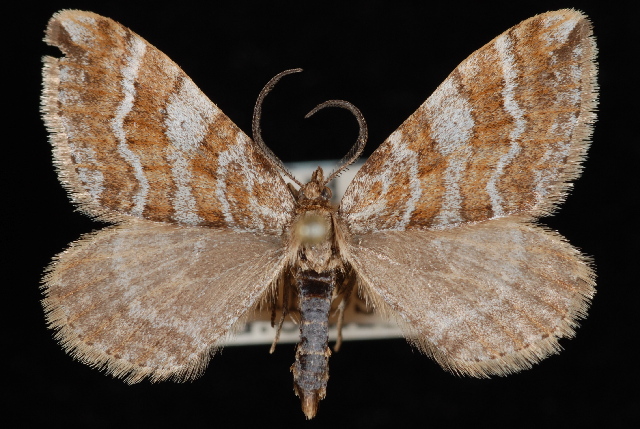Animalia: Arthropoda: Insecta: Lepidoptera: Geometridae: Larentiinae: Xanthorhoini: Xanthorhoe clarkeata (Douglas Ferguson, 1987)
The Xanthorhoe clarkeata are a newly discovered species of geometrid moth as of 1987. They live primarily on the Haida Gwaii Islands of British Columbia. This species is likely endemic to only these islands, making it a rare and unique species to Canada. Much like most geometrid moths, the females of X. clarkeata are totally wingless! The odd traits don’t end there, the unusual larval form of geometrid moths are known as inchworms. They gain their name from their interesting looping movement pattern thanks to a complete lack of legs in their middle section. Since the caterpillars only have two pairs of rear legs and three pairs of front legs, they anchor their rear legs, extend, and pull their body forward with their front legs giving the appearance of “inching” forward or “measuring” the earth as they walk. The movement of the caterpillars also gives way to their Greek family name: “Geometridae” or “earth measurer”. There are 2,188 geometrid moths with barcodes on BOLD. #Canada150 #Biodiversity150


Here’s the barcode sequence information for this species:
Process ID: LNAUS1730-13
nucleotide sequence
AACTTTATATTTTATTTTTGGAATTTGAGCAGGAATAATTGGAACATCTTTAAGTTTATTAATTCGAGCCGAATTAGGAAATCCAGGATCCTTAATTGGAGATGATCAAATTTATAATACTATTGTTACAGCTCATGCTTTTATTATAATTTTCTTCATAGTAATACCTATTATAATCGGAGGATTTGGTAATTGATTGGTACCTTTAATGTTAGGGGCCCCTGATATAGCATTCCCTCGAATAAATAATATAAGATTTTGATTACTACCACCTTCAATTACTTTATTAATTTCAAGAAGAATTGTAGAAAATGGAGCTGGAACTGGATGAACAGTTTATCCCCCTTTATCCTCTAATATTGCTCATGGAGGTAGATCAGTTGATTTAGCTATTTTCTCTCTTCATTTAGCTGGAATTTCTTCAATTTTAGGAGCTATTAATTTTATTACAACTATTATTAACATGCGATTAAATAATATATTTTTTGATCAATTACCTTTATTTGTTTGAGCTGTCGGAATTACAGCATTTTTATTATTACTATCTTTACCAGTTTTAGCTGGGGCTATTACTATATTATTAACAGATCGAAATTTAAATACCTCATTTTTTGATCCTGCTGGAGGAGGAGATCCTATTCTATATCAACATTTATTT
amino acid sequence
TLYFIFGIWAGMIGTSLSLLIRAELGNPGSLIGDDQIYNTIVTAHAFIMIFFMVMPIMIGGFGNWLVPLMLGAPDMAFPRMNNMSFWLLPPSITLLISSSIVENGAGTGWTVYPPLSSNIAHGGSSVDLAIFSLHLAGISSILGAINFITTIINMRLNNMFFDQLPLFVWAVGITAFLLLLSLPVLAGAITMLLTDRNLNTSFFDPAGGGDPILYQHLF

Learn more about it’s BIN (Barcode Index Number): BOLD:AAH9158
























